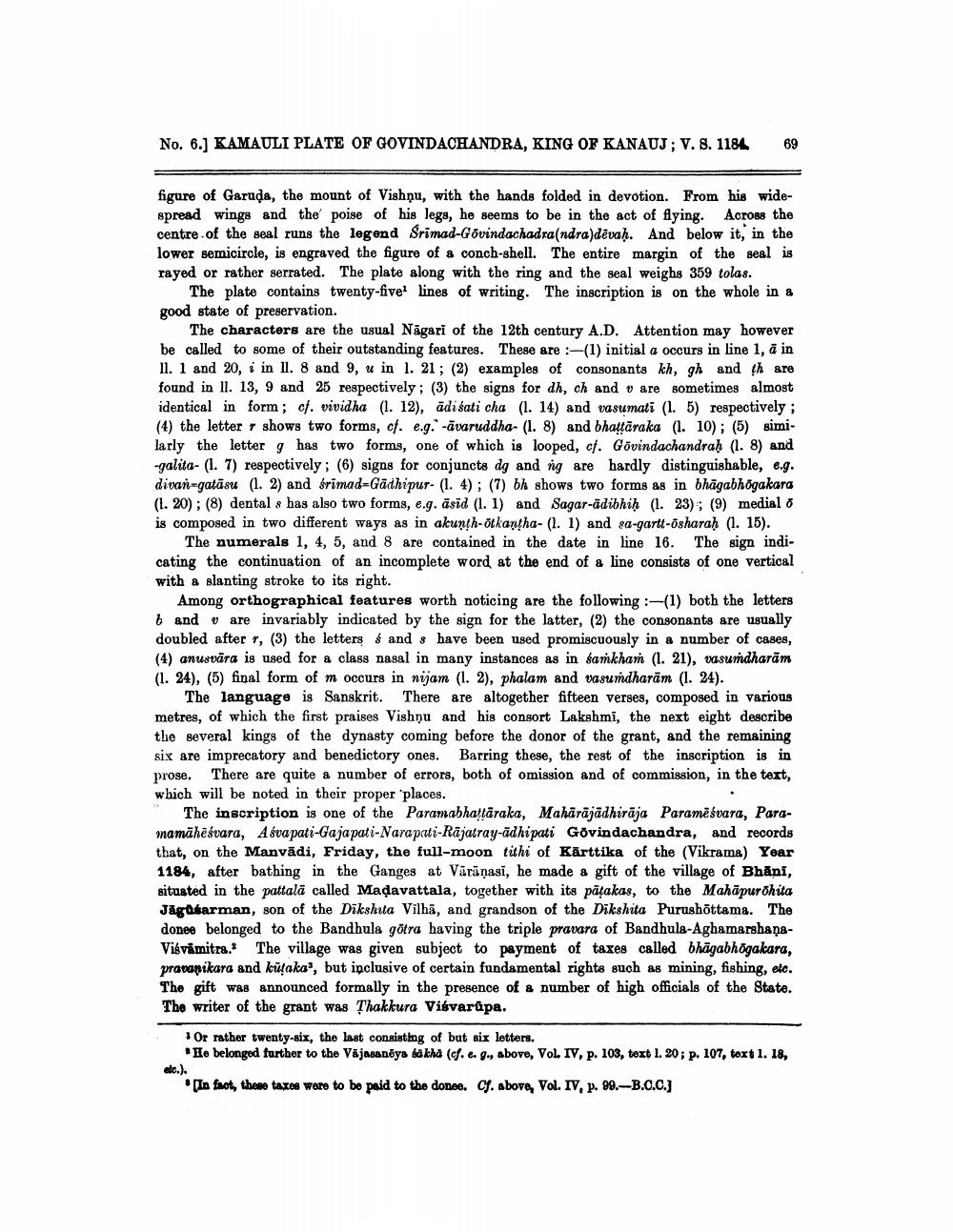________________
No. 6.] KAMAULI PLATE OF GOVINDACHANDRA, KING OF KANAUJ; V. S. 1184. 69
figure of Garuda, the mount of Vishnu, with the hands folded in devotion. From his widespread wings and the poise of his legs, he seems to be in the act of flying. Across the centre of the seal runs the legend Srimad-Govindachadra(ndra)devah. And below it, in the lower semicircle, is engraved the figure of a conch-shell. The entire margin of the seal is rayed or rather serrated. The plate along with the ring and the seal weighs 359 tolas.
The plate contains twenty-five1 lines of writing. The inscription is on the whole in a good state of preservation.
The characters are the usual Nagari of the 12th century A.D. Attention may however be called to some of their outstanding features. These are :-(1) initial a occurs in line 1, a in 11. 1 and 20, i in 11. 8 and 9, u in 1. 21; (2) examples of consonants kh, gh and th are found in 11. 13, 9 and 25 respectively; (3) the signs for dh, ch and v are sometimes almost identical in form; cf. vividha (1. 12), adiśati cha (1. 14) and vasumati (1. 5) respectively; (4) the letter r shows two forms, cf. e.g. -avaruddha- (1. 8) and bhattaraka (1. 10); (5) similarly the letter g has two forms, one of which is looped, cf. Govindachandraḥ (1. 8) and galita- (1.7) respectively; (6) signs for conjuncts dg and ng are hardly distinguishable, eg. divan-gatasu (1. 2) and śrimad-Gadhipur- (1. 4); (7) bh shows two forms as in bhagabhōgakara (1. 20); (8) dental & has also two forms, e.g. asid (1. 1) and Sagar-adibhiḥ (1. 23); (9) medial ō is composed in two different ways as in akunth-otkantha- (1. 1) and sa-gartt-ōsharaḥ (1. 15).
The numerals 1, 4, 5, and 8 are contained in the date in line 16. The sign indicating the continuation of an incomplete word at the end of a line consists of one vertical with a slanting stroke to its right.
Among orthographical features worth noticing are the following:-(1) both the letters b and v are invariably indicated by the sign for the latter, (2) the consonants are usually doubled after r, (3) the letters and s have been used promiscuously in a number of cases, (4) anusvāra is used for a class nasal in many instances as in samkham (1. 21), vasuṁdharām (1. 24), (5) final form of m occurs in nijam (1. 2), phalam and vasumdharām (1. 24).
The language is Sanskrit. There are altogether fifteen verses, composed in various metres, of which the first praises Vishnu and his consort Lakshmi, the next eight describe the several kings of the dynasty coming before the donor of the grant, and the remaining six are imprecatory and benedictory ones. Barring these, the rest of the inscription is in prose. There are quite a number of errors, both of omission and of commission, in the text, which will be noted in their proper places.
The inscription is one of the Paramabhaṭṭāraka, Mahārājādhirāja Paramēśvara, Paramamāhēśvara, Asvapati-Gajapati-Narapati-Rajatray-adhipati Govindachandra, and records that, on the Manvādi, Friday, the full-moon tithi of Karttika of the (Vikrama) Year 1184, after bathing in the Ganges at Varanasi, he made a gift of the village of Bhāni, situated in the pattală called Maḍavattala, together with its pāṭakas, to the Mahapurohita Jägusarman, son of the Dikshita Vilha, and grandson of the Dikshita Purushottama. The donee belonged to the Bandhula gōtra having the triple pravara of Bandhula-AghamarshanaVisvamitra. The village was given subject to payment of taxes called bhāgabhōgakara, pravanikara and kutaka3, but inclusive of certain fundamental rights such as mining, fishing, etc. The gift was announced formally in the presence of a number of high officials of the State. The writer of the grant was Thakkura Viśvarupa.
Or rather twenty-six, the last consisting of but six letters.
*He belonged further to the Vajasaneya bakha (cf. e. g., above, Vol. IV, p. 103, text 1. 20; p. 107, text 1. 18,
etc.).
[In fact, these taxes were to be paid to the donee. Cf. above, Vol. IV, p. 99.-B.C.C.]




